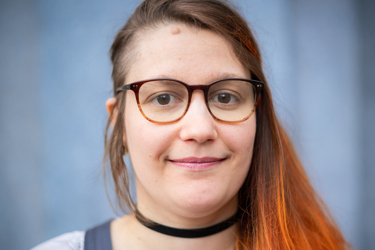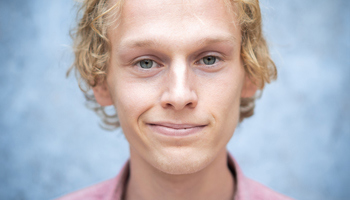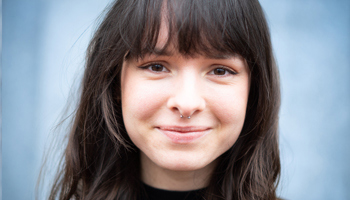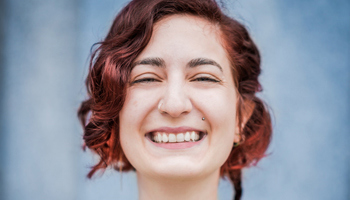
Myriam Dufrier’s childhood was filled with creative pursuits even before working in games. During her studies, she loved the versatility of environment storytelling and putting ideas together in-game – and now dedicates herself to the craft at Guerrilla.
Environment Artist Myriam Dufrier tells us about her creative hobbies growing up, how they led to her career in games, and what she loves about working in environment art.
Hello, Myriam – thanks for talking with us today! We’re excited to learn more about your role as Environment Artist at Guerrilla. Can you start by telling us a little bit about your background?
Hi! I’m Myriam Dufrier, Environment Artist at Guerrilla. I’m originally from France; I grew up in the towns of Pontarlier and Besançon. I was in an applied arts course in high school that taught the basics for a lot of design-related jobs before attending Supinfogame RUBIKA, where I did my Master’s Degree in Game Art and Management. I also had violin and music classes until my upper studies!
What was it like growing up in France?
I was born in Normandy, but the first part of my childhood I can remember is in Pontarlier, a small cozy town in the Franche-Comte region in France. People feel like a community there. They have a very strong dialect accent and a love of cheese! Every year, there was a big artisan market we’d visit with little activities to learn how to make things. The snow plow would create mountains of snow in front of our house and we would build little igloos or build the biggest of snowmen there.
In middle school, I moved to Besançon, a charming (and more touristic) city with a big castle called the Citadelle, which got UNESCO classified due to its Vauban architecture. One of the city’s specialties is clockwork! It’s a cool place if you visit: it has a fortified town center, is Victor Hugo’s town of birth, and where Louis Pasteur did a part of his studies.
It sounds like you lived in really interesting places before you came to Amsterdam. What sort of hobbies did you have while growing up in these cities?
I’ve always been on the creative side: I loved drawing, sculpting with clay, and writing stories with my sister. I loved creating visual things in any medium and using my imagination. I also have a very strong connection with music, through singing and playing the violin primarily, but it then expanded into more instruments and eventually composing and recording my own songs.
How did you feel about video games when you were younger?
I’ve had a strong love for video games since childhood, watching my older siblings play and cheering them on, and then playing by myself when I was old enough. We played games like Super Mario Bros, Duck Hunt and Chip and Dale - Rescue Rangers on the NES. When my brother got a PS1, my sister and I’d be on the couch watching him play Final Fantasy VII, asking him to use the invocation of the "ice lady" (the Shiva Materia) because we found her so cool.
After my mom noticed how much we loved playing video games, she bought a PlayStation 2 for us! My sister and I were older then, so we got our own games like Final Fantasy VIII/IX/X, Dark Chronicles – we even played some games on the PC, but it was easier to play on console and take turns since we only had one PC to use.
Video games have been a big part of my life; I found them amazing – getting to explore worlds and discovering the character's stories with them was always exciting.
You had so many creative hobbies – how did you come to decide to pursue working in gaming for your career?
Until halfway through middle school, I actually wanted to be a singer! When it came to school, I was really into music, art, and science. While singing was a dream, it felt like I had to find something else eventually.
One day, my sister was researching what job she wanted to pursue, so I grabbed one of her job list magazines out of curiosity and saw “game designer”. That’s when it clicked: “People make the video games I love so much. It’s a job!” And, well, it consists of art, music and science, so it was a perfect match!
After I realized this, the path to get here was still uncertain. It wasn’t a very common job path to take. I didn’t know who or where to ask, so I’d read magazines about it with my mom. One summer, I attended a Go (strategy board game) learning camp and met Christophe, who had been working in the VFX industry for animated movies. He kindly showed me how 3D worked, giving me some pointers. Once I tried 3D modeling, my mind was set!
Later, I participated in a summer camp where I learned how to use RPG Maker and GameMaker. It snowballed from there.
Are there any particular video games that inspired you to pursue a career in game development?
Final Fantasy IX is an easy first, with Final Fantasy VII coming a close second!
In general, Final Fantasy is a franchise I hold close to my heart. I’m in awe of their cinematics, characters and their stories, and it’s become a bit of a family thing. My parents didn’t play the games at all, but we’d talk to them so much about them that eventually, my mom learned how to play some of the songs on her piano and even recognized the Chocobo song!
Final Fantasy IX’s universe, art direction and themes really resonated with me and made me want to make worlds that inspire people and make them excited to explore…
Even within game disciplines, it sounds like you’d have several directions you’d go in. How did you come to specialize in environment art?
When I started game school, I was still indecisive and thought I might be a character artist – I draw a lot of characters because I connect with them so easily. I liked the idea of being able to understand a person’s story through their design.
But as I continued my games studies, I realized environmental storytelling was just as fascinating. I just really liked talking with many different fields to figure out “how to make it a game”, putting out ideas together, and making environments people enjoy playing in.
Environment art is such a versatile discipline: you need to know how to do a bit of everything and you’re always learning. It has so many stages in production that I hardly get bored doing the same thing!
After you realized you wanted to specialize in environment art, how did your path to working here at Guerrilla and living in Amsterdam start?
During my Master’s program, I did my internship at Paladin Studios in Den Haag and I loved the mentality of the people living here in the Netherlands. After my internship, I finished my studies and started working as an Environment Artist at Ys Interactive and then as a Level Artist at Ubisoft Annecy, where I worked on The Division 2 and XDefiant.
Then the pandemic hit. My long-distance partner was living in Amsterdam and it made me realize that I wanted to live closer than a plane or train ride away.
I looked into moving to Amsterdam and possibly joining Guerrilla, because I’d always had a love for the Horizon franchise: I related to Aloy a lot and I just loved the universe and themes. As a student, I had done a graduation project which shared similar themes as Horizon (tribal elements in a post-post-apocalyptic lush setting, with technology used from the old ones) and I connected so much to the universe.
When Guerrilla released Horizon Forbidden West’s trailer, it felt like the perfect time to apply. There was no role for Environment Artist at the time so I did an open application, thinking maybe one day they’ll reply. But three weeks later, I got an interview and spoke to different teams about what I could do. I started at Guerrilla a few months later and here I am!
Compared to the cities you’ve lived in while in France, what do you think about your life here in Amsterdam?
I tend to find big cities intimidating, but Amsterdam has all of the good parts of small cities – cute canal streets, calm spaces to explore without being overwhelmed – with all of the conveniences of bigger cities!
I miss the mountains, but I just really love taking a stroll in town close to the canals, picking a new direction each time.
As an Environment Artist, what do you do here at Guerrilla?
Environment art is a bit like being an interior/exterior decorator but for games. We get an idea of what kind of space we should make, what narrative happens in it, the technical requirements. From that, we define what kind of furniture would fit best, what color the walls should be, what kind of trees to place, and compose the game space visually.
We work alongside level designers, who place little boxes to show us what the intentions are (where the player takes cover, finds hints). It’s our job to change the box into a believable and pretty 3D space.
It leads to researching a lot of interesting subjects. For example, to create a Forge, we’d research what’s the structure of a forge, what tools are needed to do it and the process of a blacksmith, to help the space be “believable”. So we end up learning a lot of small things along the way!
We also need technical knowledge and know the limits, because if too many different objects are placed, the game can’t run anymore. Environment art is a field that puts ideas together in-game. It’s a very versatile and fun job: nothing is ever the same and every space has its own challenges.
What do you enjoy most about it? Are there any challenging things about the process of working in environment art?
What I love the most about environment art is the environmental storytelling! It’s the idea that when the player enters the space, they can understand everything that happened there (when seeing a ball next to a broken window, people associate the ideas together and understand what happened).
The Horizon franchise has many layers of this. There’s the Old World: how it used to be, what happened in the 1000-year gap, and what the area is now. It even differs between making an Old World ruin that players go to explore and was untouched (“How would people have left it?”), or a tribal space where people are living right now (“What are their customs and personality?”).The challenges are usually around finding the right balance between art and gameplay. It’s always a lot of back and forth. Some level designer compositions are fun to play, but it doesn’t match the scale or theme of what we intend to do with art.
It’s a lot about finding the best of both worlds, and taking the good compromises to make a fun and pretty space. Then there are technical challenges for the game to run. The more games evolve in tech, the harder it can get to understand how everything works, so we have to keep up with software evolving and new requirements and tools. But we thankfully have a group of smart Technical Artists that can help us with it!
Who do you and your team work with most? Can you tell us about that collaboration?
We work primarily with level designers (they make the shell we start from), but also with a lot of different disciplines. Concept artists help define the mood for the most important spaces. While we make little 3D prototypes of the objects we need, Prop/Asset Artists make the final 3D models we place. Lighting Artists will add lights for the space to be readable to the player. With the variety of spaces we work on, I think we eventually end up collaborating with every game development field.
On the environment team itself, most of our interactions are about giving feedback and receiving feedback, and solving issues together. There’s a healthy mood in the team and a regular occurrence of cookies!
Your work is so visual – we’d love to know your favorite thing you worked on here!
I loved working on “The Stars in Their Eyes” mission in the Burning Shores DLC! It’s a symbolic mission for me. I’d originally joined Guerrilla as part of the Underground/Bunkers/Ruins team to work in San Francisco, but I’d always been curious about the workflow concerning the tribes and settlements. I loved getting to create a part of Heaven’s Rest, a settlement as part of the mission. It was my first experience making a tribe-related space!
You may have inspired a new generation of environment artists here! What would be your advice for those interested in pursuing this discipline?
Everything comes with practice. Ask for feedback and don’t be too harsh on yourself. Every time you do a new project, you learn new things for the next one.
For environment art specifically, there are very helpful communities online (Dinusty Empire Discord, Experience Points Discord, Polycount) full of artists that give good feedback for every level across professionals, students, and hobbyists. Joining online communities helps a lot with motivation to finish projects and networking and I highly recommend it. If you can afford to go to a school, being together with other students who want to do different jobs and getting the general knowledge of different fields in the games industry is quite valuable. It’ll teach you to work in a team and to have a basic understanding of how every field works, which helps you communicate with your colleagues in the future. Game Jams can also help with learning to work in teams, though they are more intense.
Basic art composition rules apply to environment art. It’s very helpful to know how to draw (or at least sketch ideas), to give feedback or show your intentions. Environment art is also teamwork! It’s important to be versatile and know how to adapt, and to work with others.
That’s very helpful! Do you have anything else you’d like to share with our readers?
I want to give some advice about the pressure we put on ourselves. Before I joined my previous job at Ubisoft Annecy, my portfolio was mostly composed of stylized characters, drawings, and one stylized environment from my internship/freelance time at Ys Interactive on “Blacksad: Under the Skin”. I was posting things I liked doing, training on the side to do realistic things eventually, but I thought, “It’s not good enough – I can’t post it or apply yet”.
It turns out Ubisoft Annecy contacted me first instead, to work on “Tom Clancy's The Division 2”. While it wasn’t the style they were going for, they said, “We think you can do the job” – and gave me a test to see if I could model realistic things. Opportunities can happen very fast and without warning. But it showed me that it’s not on me to judge if I’m good enough for the job in the end. Sometimes we set the bar so high, we never apply! But a lot of things are learned on the way and a team is stronger if its members have different strengths. I’ve gotten to learn that mine are communication and adaptability/versatility!
With determination you can go very far – so good luck!



